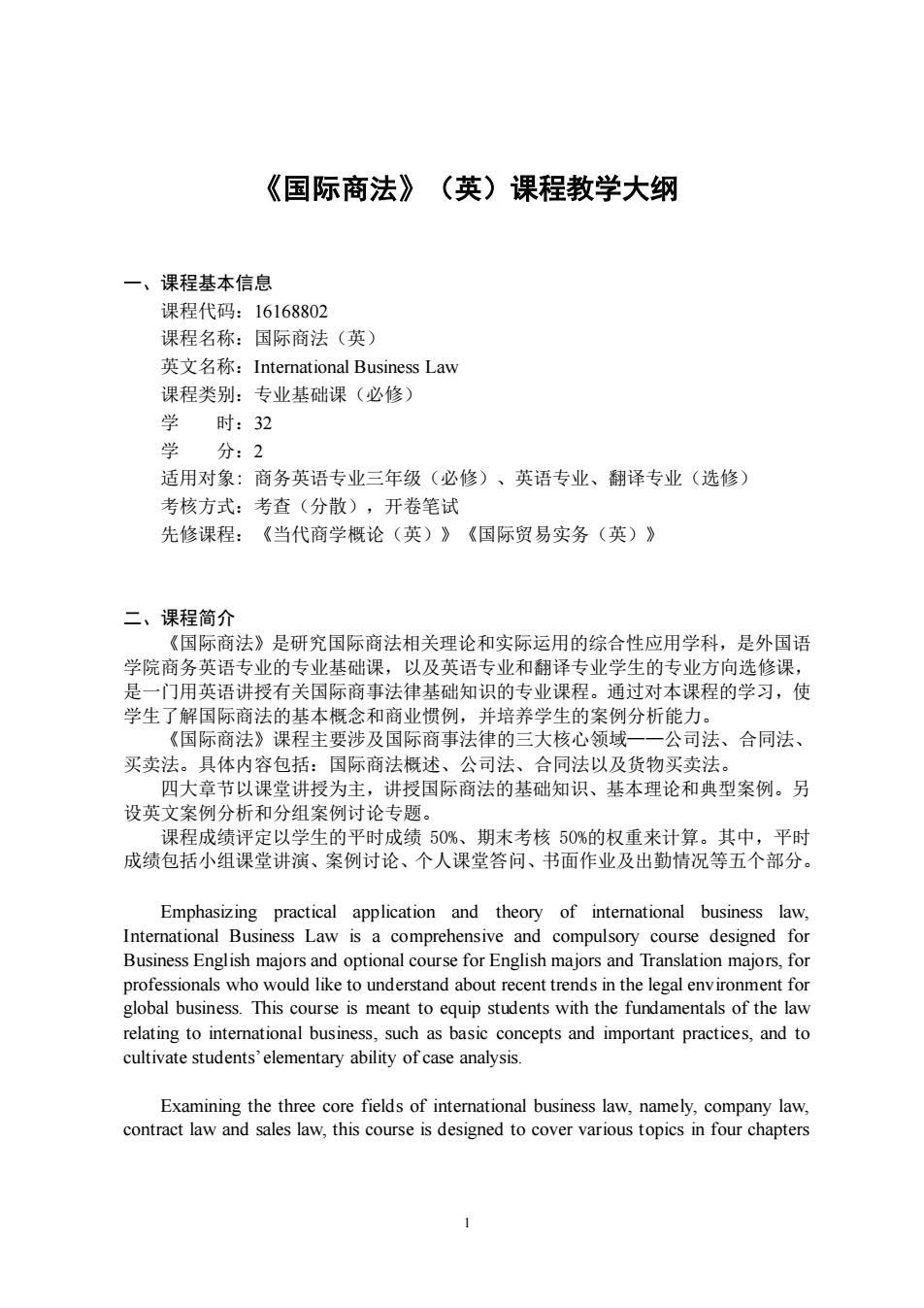
《国际商法》(英)课程教学大纲 一、课程基本信息 课程代码:16168802 课程名称:国际商法(英) 英文名称:International Business Law 课程类别:专业基础课(必修) 学 时:32 分:2 适用对象:商务英语专业三年级(必修)、英语专业、翻译专业(选修) 考核方式:考查(分散),开卷笔试 先修课程:《当代商学概论(英)》《国际贸易实务(英)》 二、课程简介 《国际商法》是研究国际商法相关理论和实际运用的综合性应用学科,是外国语 学院商务英语专业的专业基础课,以及英语专业和翻译专业学生的专业方向选修课, 是一门用英语讲授有关国际商事法律基础知识的专业课程。通过对本课程的学习,使 学生了解国际商法的基本概念和商业惯例,并培养学生的案例分析能 《国际商法》课程主要涉及国 商事法律的三大核心领域 司法、合同法 买卖法。具体内容包括:国际商法概述、公司法、合同法以及货物买卖法。 四大章节以课堂讲授为主,讲授国际商法的基础知识、基本理论和典型案例。另 设英文案例分析和分组案例讨论专题。 里程成结评定以学生的平时成结50%、期末老核50%的权重来计管。其中.平时 成绩包括小组课堂讲演、案例讨论、 个人课堂答问、书面作业及出勤情况等五个部分。 Emphasizing practical application and theory of international business law. International Business Law is a comprehensive and compulsory course designed for Business English majo nd optio e for English majo majors,fo profe sionals who would like to understand about recent trends in the legal environment for global business.This course is meant to equip students with the fundamentals of the law relating to international business,such as basic concepts and important practices,and to cultivate students'elementary ability of case analysis. Examining the three core fields of interational business law,namely,company law, contract law and sales law,this course is designed to cover various topics in four chapters
1 《国际商法》(英)课程教学大纲 一、课程基本信息 课程代码:16168802 课程名称:国际商法(英) 英文名称:International Business Law 课程类别:专业基础课(必修) 学 时:32 学 分:2 适用对象: 商务英语专业三年级(必修)、英语专业、翻译专业(选修) 考核方式:考查(分散),开卷笔试 先修课程:《当代商学概论(英)》《国际贸易实务(英)》 二、课程简介 《国际商法》是研究国际商法相关理论和实际运用的综合性应用学科,是外国语 学院商务英语专业的专业基础课,以及英语专业和翻译专业学生的专业方向选修课, 是一门用英语讲授有关国际商事法律基础知识的专业课程。通过对本课程的学习,使 学生了解国际商法的基本概念和商业惯例,并培养学生的案例分析能力。 《国际商法》课程主要涉及国际商事法律的三大核心领域——公司法、合同法、 买卖法。具体内容包括:国际商法概述、公司法、合同法以及货物买卖法。 四大章节以课堂讲授为主,讲授国际商法的基础知识、基本理论和典型案例。另 设英文案例分析和分组案例讨论专题。 课程成绩评定以学生的平时成绩 50%、期末考核 50%的权重来计算。其中,平时 成绩包括小组课堂讲演、案例讨论、个人课堂答问、书面作业及出勤情况等五个部分。 Emphasizing practical application and theory of international business law, International Business Law is a comprehensive and compulsory course designed for Business English majors and optional course for English majors and Translation majors, for professionals who would like to understand about recent trends in the legal environment for global business. This course is meant to equip students with the fundamentals of the law relating to international business, such as basic concepts and important practices, and to cultivate students’elementary ability of case analysis. Examining the three core fields of international business law, namely, company law, contract law and sales law, this course is designed to cover various topics in four chapters
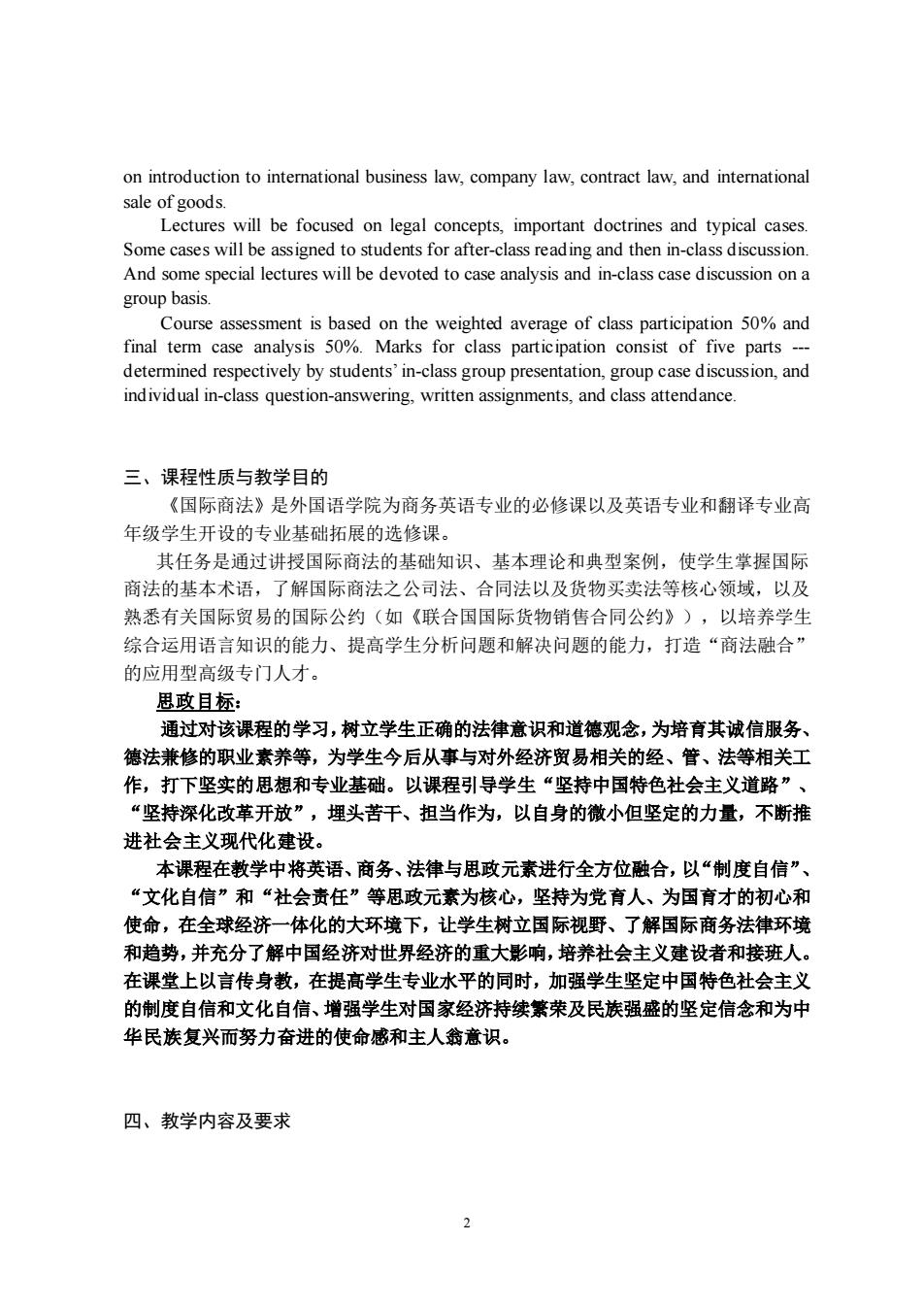
on introduction to international business law,company law,contract law,and international sale of goods Lectures will be focused on legal concepts,important doctrines and typical cases. Some cases will be assigned ents for after-clas reading an then in-clas ss discussion And some special lectures will be devoted to case analysis and in-class case discussion ona group basis. Course assessment is based on the weighted average of class participation 50%and final term case analysis 50%.Marks for class participation consist of five parts- ectively by studentsin-class group presentatior group case dis cussion,and ass question-answering,written assignments,and class attendance 三、课程性质与教学目的 《国际商法》是外国语学院为商务英语专业的必修课以及英语专业和翻译专业高 年级学生开设的专业基础拓展的选修课。 其任务是通过讲授国际商法的基础知识、基本理论和典型案例,使学生掌握国际 商法的基本术语,了解国际商法之公司法、合同法以及货物买卖法等核心领域,以及 熟悉有关国际贸易的国际公约(如《联合国国际货物销售合同公约》),以培养学生 综合运用语言知识的能力、提高学生分析问题和解决问题的能力,打造“商法融合” 的应用型高级专门人才。 思政目标: 通过对该课程的学习,树立学生正确的法律意识和道德观念,为培育其诚信服务、 德法兼修的职业素养等,为学生今后从事与对外经济贸易相关的经、管、法等相关工 作,打下坚实的思想和专业基础。以课程引导学生“坚持中国特色社会主义道路”、 “坚持深化改革开放”,埋头苦干、担当作为,以自身的微小但坚定的力量,不断推 进社会主义现代化建设。 本课程在敦学中将英语、商务、法律与思政元素进行全方位融合,以“制度自信”、 “文化自信”和“社会责任”等思政元素为核心,坚持为党育人、为国育才的初心和 使命,在全球经济一体化的大环境下,让学生树立国际视野、了解国际商务法律环境 和趋势,并充分了解中国经济对世界经济的重大彩响,培养社会主义建设者和接班人。 在课堂上以言传身教,在提高学生专业水平的同时,加强学生坚定中国特色社会主义 的制度自信和文化自信、增强学生对国家经济持续繁荣及民族强盛的坚定信念和为中 华民族复兴而努力奋进的使命感和主人翁意识。 四、教学内容及要求
2 on introduction to international business law, company law, contract law, and international sale of goods. Lectures will be focused on legal concepts, important doctrines and typical cases. Some cases will be assigned to students for after-class reading and then in-class discussion. And some special lectures will be devoted to case analysis and in-class case discussion on a group basis. Course assessment is based on the weighted average of class participation 50% and final term case analysis 50%. Marks for class participation consist of five parts --- determined respectively by students’ in-class group presentation, group case discussion, and individual in-class question-answering, written assignments, and class attendance. 三、课程性质与教学目的 《国际商法》是外国语学院为商务英语专业的必修课以及英语专业和翻译专业高 年级学生开设的专业基础拓展的选修课。 其任务是通过讲授国际商法的基础知识、基本理论和典型案例,使学生掌握国际 商法的基本术语,了解国际商法之公司法、合同法以及货物买卖法等核心领域,以及 熟悉有关国际贸易的国际公约(如《联合国国际货物销售合同公约》),以培养学生 综合运用语言知识的能力、提高学生分析问题和解决问题的能力,打造“商法融合” 的应用型高级专门人才。 思政目标: 通过对该课程的学习,树立学生正确的法律意识和道德观念,为培育其诚信服务、 德法兼修的职业素养等,为学生今后从事与对外经济贸易相关的经、管、法等相关工 作,打下坚实的思想和专业基础。以课程引导学生“坚持中国特色社会主义道路”、 “坚持深化改革开放”,埋头苦干、担当作为,以自身的微小但坚定的力量,不断推 进社会主义现代化建设。 本课程在教学中将英语、商务、法律与思政元素进行全方位融合,以“制度自信”、 “文化自信”和“社会责任”等思政元素为核心,坚持为党育人、为国育才的初心和 使命,在全球经济一体化的大环境下,让学生树立国际视野、了解国际商务法律环境 和趋势,并充分了解中国经济对世界经济的重大影响,培养社会主义建设者和接班人。 在课堂上以言传身教,在提高学生专业水平的同时,加强学生坚定中国特色社会主义 的制度自信和文化自信、增强学生对国家经济持续繁荣及民族强盛的坚定信念和为中 华民族复兴而努力奋进的使命感和主人翁意识。 四、教学内容及要求

3
3
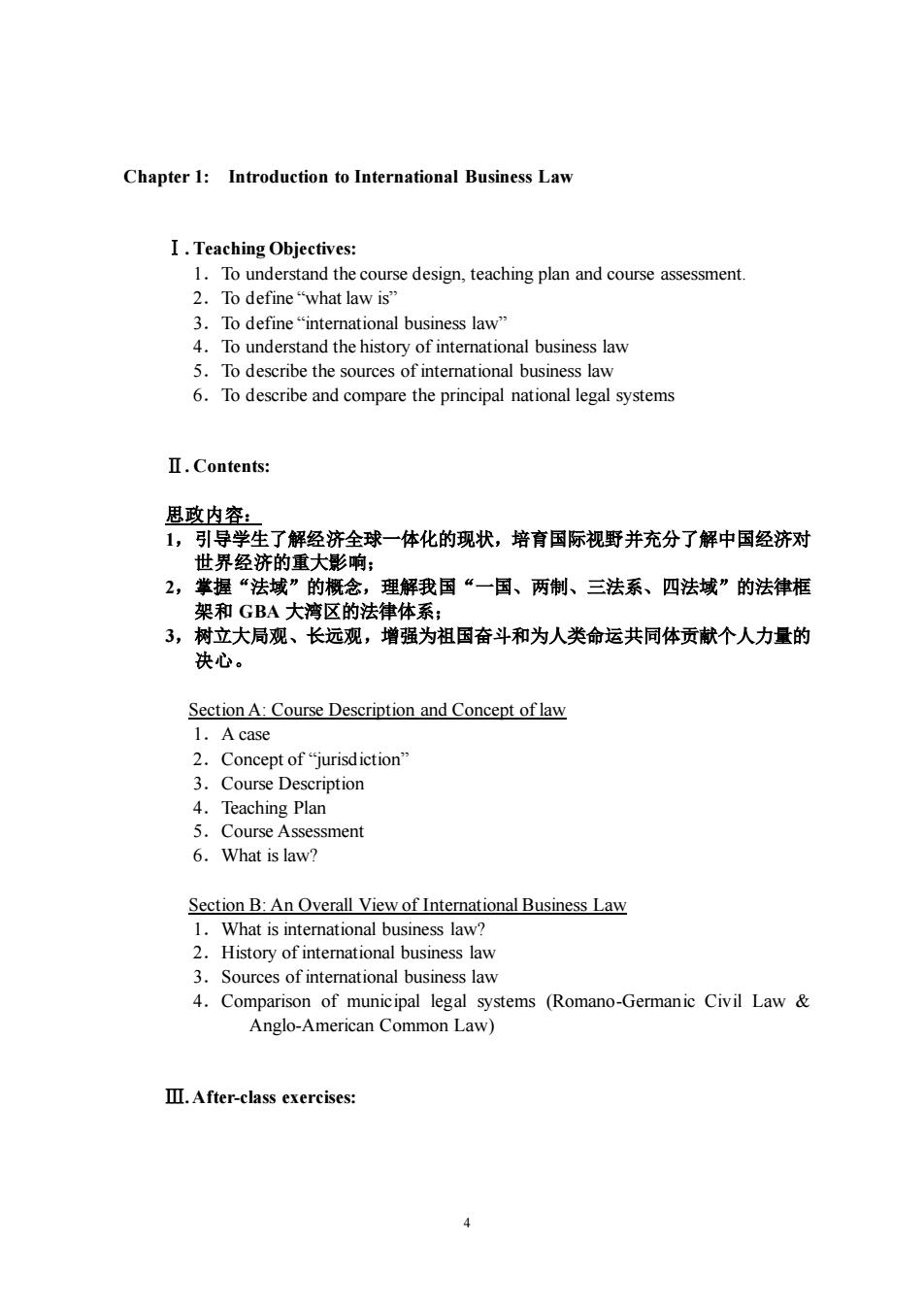
Chapter 1:Introduction to International Business Law I.Teaching Objectives: 1.To understand the course design,teaching plan and course assessment 2.To define"what law is" 3.To define"international business law" 4.To understand the history of international business law ess law To describe and compare the principal national legal systems II.Contents: 思政内容: 1,引导学生了解经济全球一体化的现状,培有国际视野并充分了解中国经济对 世乡 界经济的重 影啊 2,掌握“法域”的概念,理解我国“一国、两制、三法系、四法域”的法律框 架和GBA大湾区的法律体系; 3,树立大局观、长远观,增强为祖国奋斗和为人类命运共同体贡献个人力量的 决心。 Section A:Course Description and Concept of law 1.A case Course De escription 4.Teaching Plan 5.CourseAssessment 6.What is law? Section B:An Overall View of International Business Law 1.What is international business law? 2.History of international business law 3.Sources of international business law 4.Comparison of municipal legal systems (Romano-Germanic Civil Law& Anglo-American Co mmon Law) III.After-class exereises: 4
4 Chapter 1: Introduction to International Business Law Ⅰ. Teaching Objectives: 1.To understand the course design, teaching plan and course assessment. 2.To define “what law is” 3.To define “international business law” 4.To understand the history of international business law 5.To describe the sources of international business law 6.To describe and compare the principal national legal systems Ⅱ. Contents: 思政内容: 1,引导学生了解经济全球一体化的现状,培育国际视野并充分了解中国经济对 世界经济的重大影响; 2,掌握“法域”的概念,理解我国“一国、两制、三法系、四法域”的法律框 架和 GBA 大湾区的法律体系; 3,树立大局观、长远观,增强为祖国奋斗和为人类命运共同体贡献个人力量的 决心。 Section A: Course Description and Concept of law 1.A case 2.Concept of “jurisdiction” 3.Course Description 4.Teaching Plan 5.Course Assessment 6.What is law? Section B: An Overall View of International Business Law 1.What is international business law? 2.History of international business law 3.Sources of international business law 4.Comparison of municipal legal systems (Romano-Germanic Civil Law & Anglo-American Common Law) Ⅲ.After-class exercises:

A Review and Summary of this chapter. Preparation for group presentation on a given topic IV.Teaching methods and aids Lectures with PPT in a multimedia classroom,Q&A,presentation,case study, and group discussions
5 A Review and Summary of this chapter; Preparation for group presentation on a given topic. Ⅳ. Teaching methods and aids: Lectures with PPT in a multimedia classroom, Q & A, presentation, case study, and group discussions
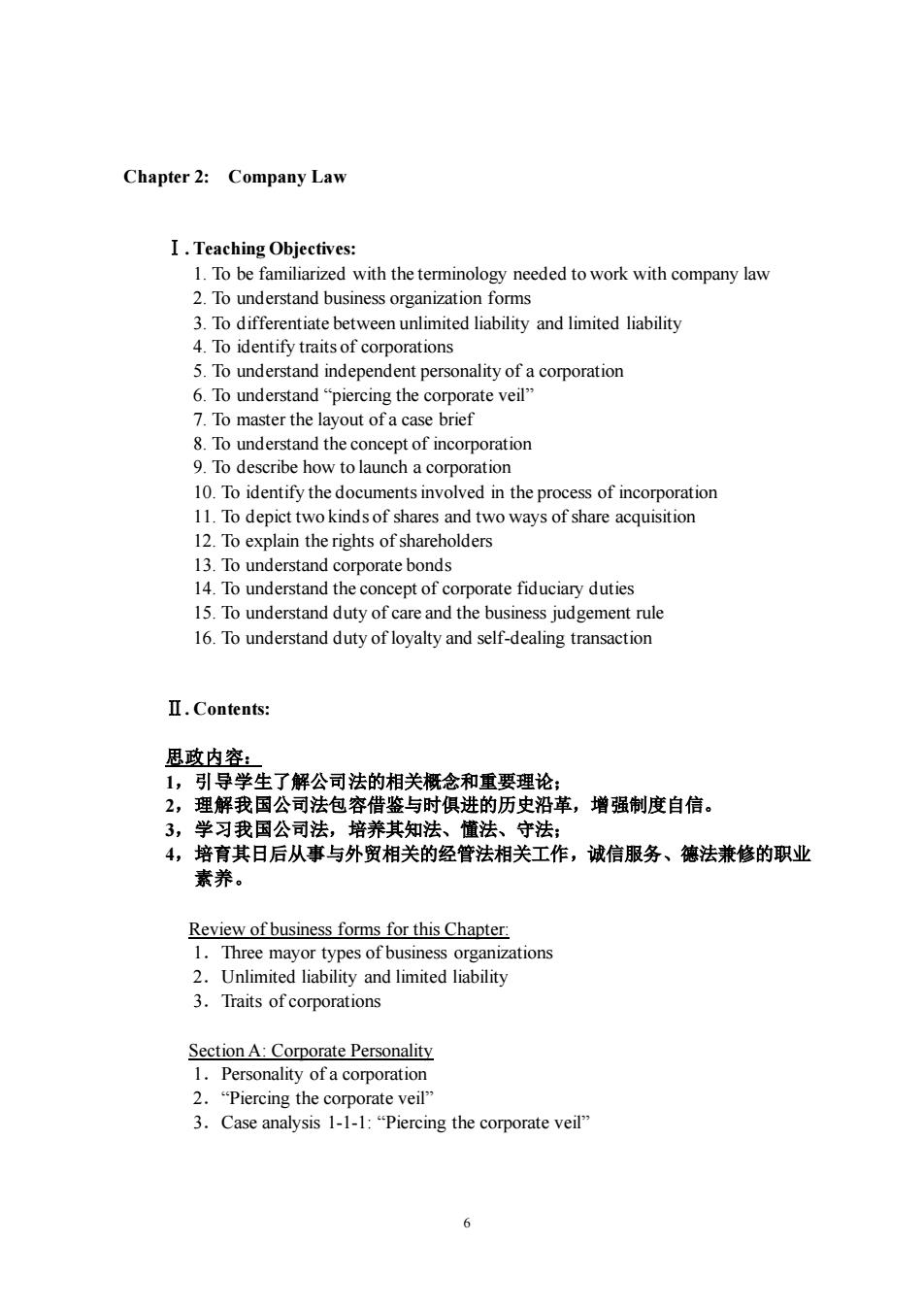
Chapter 2:Company Law I.Teaching Objectives: 1.To be familiarized with the terminology needed to work with company law 2.To understand business organization forms 3.To differentiate between unlimited liability and limited liability 4 To identify traits of corporations 5.To under nd indeper ent personality of a corporation 6.To understand"piercing the corporate veil 7.To master the layout of a case brief 8.To understand the concept of incorporation 9.To describe how to launch a corporation 10.To identify the documents involved in the process of inc p 11.To depict twokindsof sha and two ways of share acquisit 12.To explain the rights of shareholders 13.To understand corporate bonds 14.To understand the concept of corporate fiduciary duties 15.To understand duty of care and the business judgement rue 16.To understand duty of loyalty and self-dealing transaction Ⅱ.Contents: 思政内容: 理解我国 公司法包容借鉴与时俱进的历史沿革,增强制度自信, 3,学习我国公司法,培养其知法、懂法、守法: 4,培育其日后从事与外贸相关的经管法相关工作,诚信服务、德法兼修的职业 素养。 Review of business forms for this Chapter 1.Three mavor types of business organizations 2.Unlimited liability and limited liability 3.Traits of corporations Section A:Corporate Personality 1.Personality of a corporation 2."Piercing the corporate veil" 3.Case analysis 1-1-1:"Piercing the corporate veil" 6
6 Chapter 2: Company Law Ⅰ. Teaching Objectives: 1. To be familiarized with the terminology needed to work with company law 2. To understand business organization forms 3. To differentiate between unlimited liability and limited liability 4. To identify traits of corporations 5. To understand independent personality of a corporation 6. To understand “piercing the corporate veil” 7. To master the layout of a case brief 8. To understand the concept of incorporation 9. To describe how to launch a corporation 10. To identify the documents involved in the process of incorporation 11. To depict two kinds of shares and two ways of share acquisition 12. To explain the rights of shareholders 13. To understand corporate bonds 14. To understand the concept of corporate fiduciary duties 15. To understand duty of care and the business judgement rule 16. To understand duty of loyalty and self-dealing transaction Ⅱ. Contents: 思政内容: 1,引导学生了解公司法的相关概念和重要理论; 2,理解我国公司法包容借鉴与时俱进的历史沿革,增强制度自信。 3,学习我国公司法,培养其知法、懂法、守法; 4,培育其日后从事与外贸相关的经管法相关工作,诚信服务、德法兼修的职业 素养。 Review of business forms for this Chapter: 1.Three mayor types of business organizations 2.Unlimited liability and limited liability 3.Traits of corporations Section A: Corporate Personality 1.Personality of a corporation 2.“Piercing the corporate veil” 3.Case analysis 1-1-1: “Piercing the corporate veil
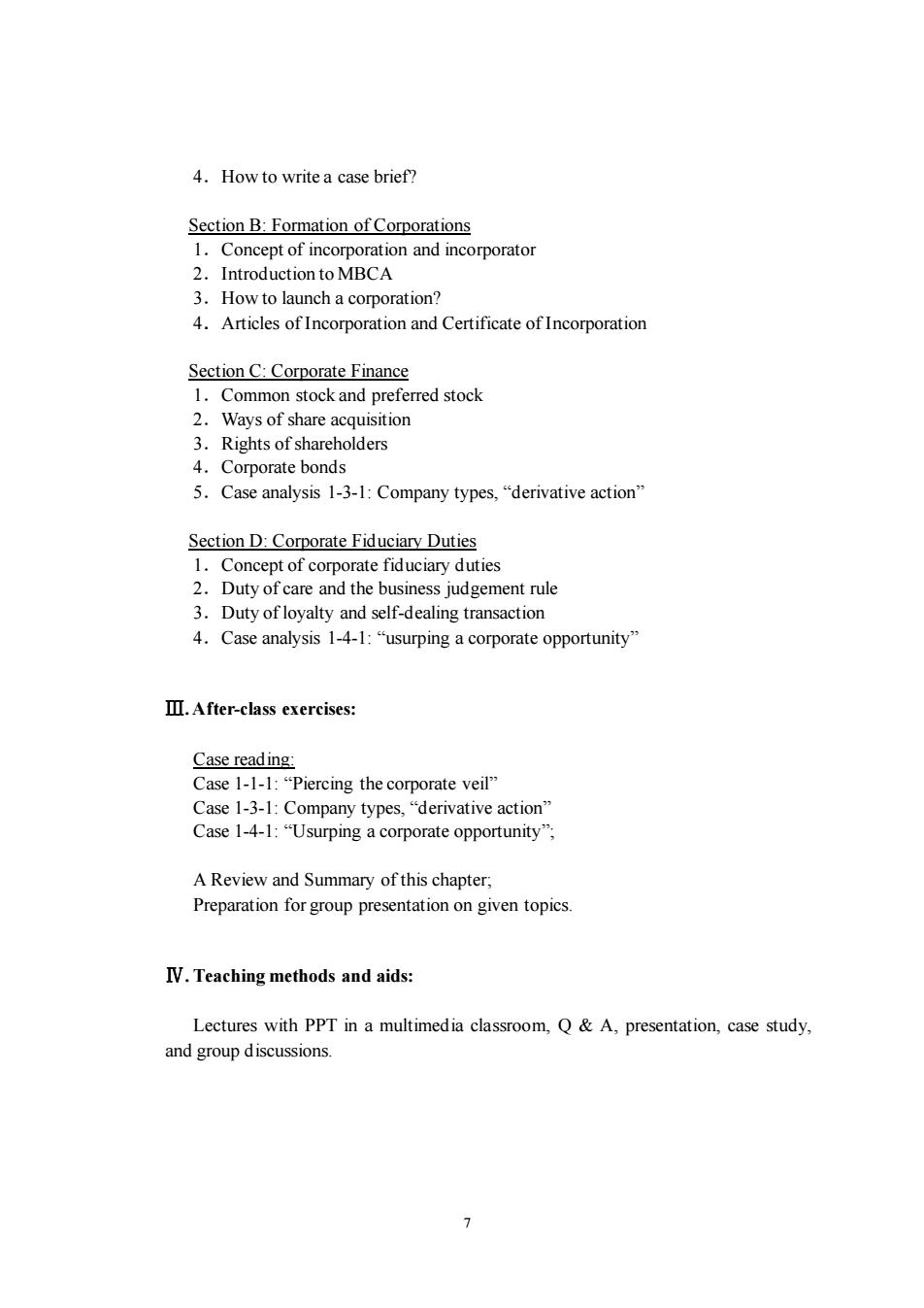
4.How to write a case brief? Section B:Formation of Corporations 1.Concept of incc poration and incorporator 2. Introd ction to MBCA 3.How to launch a corporation? 4.Articles of Incorporation and Certificate of Incorporation Section C:Corporate Finance 1 Common stock and preferred stock Ways of share acquisition 3.Rights of shareholders 4.Corporate bonds 5.Case analysis 1-3-1:Company types,"derivative action' Section D:Corporate Fiduciary Duties 1.Concept of corporate fiduciary duties 2.Duty of care and the business judgement rule 3.Duty of loyalty and self-dealing transaction 4.Case analysis 1-4-1:"usurping a corporate opportunity" III.After-class exercises: "Piercing the corporate veil Case 1-3-1:Company types,"derivative action' Case 1-4-1:"Usurping a corporate opportunity" A review and summary of this chapter Preparation for group presentation on given topics IV.Teaching methods and aids: Lectures with PPT in a multimedia classroom,Q&A,presentation,case study and group discussions
7 4.How to write a case brief? Section B: Formation of Corporations 1.Concept of incorporation and incorporator 2.Introduction to MBCA 3.How to launch a corporation? 4.Articles of Incorporation and Certificate of Incorporation Section C: Corporate Finance 1.Common stock and preferred stock 2.Ways of share acquisition 3.Rights of shareholders 4.Corporate bonds 5.Case analysis 1-3-1: Company types, “derivative action” Section D: Corporate Fiduciary Duties 1.Concept of corporate fiduciary duties 2.Duty of care and the business judgement rule 3.Duty of loyalty and self-dealing transaction 4.Case analysis 1-4-1: “usurping a corporate opportunity” Ⅲ.After-class exercises: Case reading: Case 1-1-1: “Piercing the corporate veil” Case 1-3-1: Company types, “derivative action” Case 1-4-1: “Usurping a corporate opportunity”; A Review and Summary of this chapter; Preparation for group presentation on given topics. Ⅳ. Teaching methods and aids: Lectures with PPT in a multimedia classroom, Q & A, presentation, case study, and group discussions
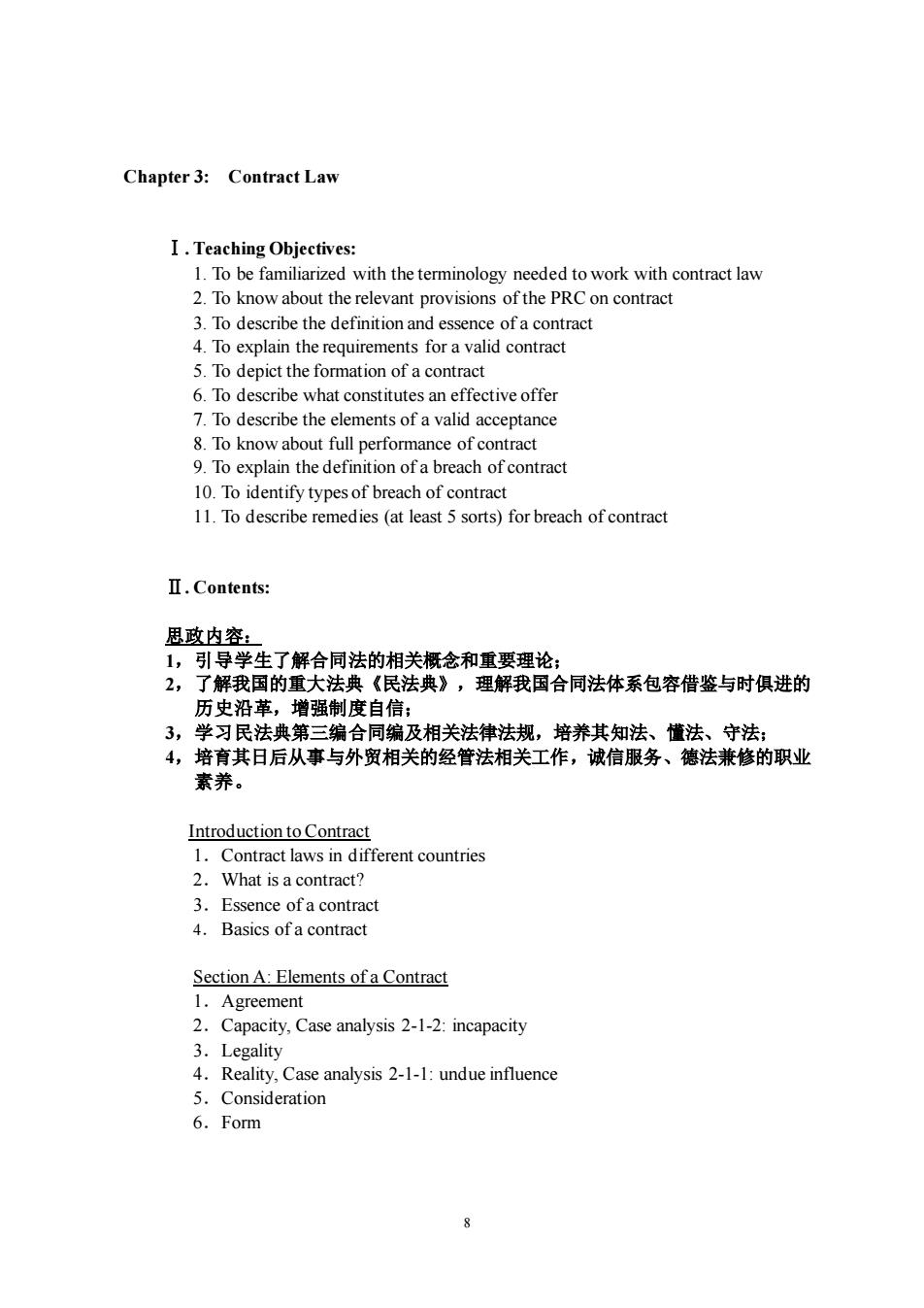
Chapter 3:Contract Law I.Teaching Objectives: To be familiarized with the terminology needed to work with contract law 2.To know about the relevant provisions of the PRC on contract 3.To describe the definition and essence of a contract 4.To explain the requirements for a valid contract 6 To describe what constitutes an effective offe 7.To describe the elements of a valid acceptance 8.To know about full performance of contract 9.To explain the definition of a breach of contract 10.To identify typesof breach of contract 11.To describe remedies (at least 5 sorts)for breach of contract II.Contents: 思政内容: 引导学生了解合同法的相关概念和重要理论: 2, 了解我目 的重大法典《民法典》,理解我国合同法体系包容借鉴与时俱进的 历史沿革,增强制度自信: 3,学习民法典第三编合同编及相关法律法规,培养其知法、懂法、守法; 4,培育其日后从事与外贸相关的经管法相关工作,诚信服务、德法兼修的职业 素养。 Introduction to Contract 1.Contract laws in different countries 2.What is a contract? 3 Essence of a cont Basics of a contract Section A:Elements ofa Contract 1.Agreement 2.Cap acity,Case analysis 2-1-2:incapacity 3.Legality 4.Reality.Case analysis 2-1-1:undue influence 5.Consideration 6.Form
8 Chapter 3: Contract Law Ⅰ. Teaching Objectives: 1. To be familiarized with the terminology needed to work with contract law 2. To know about the relevant provisions of the PRC on contract 3. To describe the definition and essence of a contract 4. To explain the requirements for a valid contract 5. To depict the formation of a contract 6. To describe what constitutes an effective offer 7. To describe the elements of a valid acceptance 8. To know about full performance of contract 9. To explain the definition of a breach of contract 10. To identify types of breach of contract 11. To describe remedies (at least 5 sorts) for breach of contract Ⅱ. Contents: 思政内容: 1,引导学生了解合同法的相关概念和重要理论; 2,了解我国的重大法典《民法典》,理解我国合同法体系包容借鉴与时俱进的 历史沿革,增强制度自信; 3,学习民法典第三编合同编及相关法律法规,培养其知法、懂法、守法; 4,培育其日后从事与外贸相关的经管法相关工作,诚信服务、德法兼修的职业 素养。 Introduction to Contract 1.Contract laws in different countries 2.What is a contract? 3.Essence of a contract 4. Basics of a contract Section A: Elements of a Contract 1.Agreement 2.Capacity, Case analysis 2-1-2: incapacity 3.Legality 4.Reality, Case analysis 2-1-1: undue influence 5.Consideration 6.Form

Section B:Formation ofa Contract 1.How the basic agreement arises:offer acceptance(effect of acceptance) 2.Requirements fo an effective offer Contractual intention(vinvitation of offer) b)Definiteness; c)Communication to specific offeree(s). 3.Case analysis 2-2-1:offer 4.Case analysis 3-1-1:"offervinvitation for offer" 5.Elem ents of valid acceptance a)By the offeree:Who may accept? b)Unconditional:Conform to the terms of the offer/the nature of acceptance(principle of mirror and counter-offer). c)Within the time limit fixed by the offer,or within a reasonable period ofti e ation of accepta d)Inthe proper form:The manner ofacceptance. 6.Case analysis 2-2 2:acceptance; 7.Case analysis 2-2-4:counter-offer Section C:Breach of Contract and Remedies Full performance 2.The definition and types of contract breach a)actual breach b)anticipatory breach 3.What can be one when broken:Remedies forbreach of on (7sorts) a)Specific performance b)Damages /reparations c)Liquidated damages: d)Rescission/Repudiation; Injunction/Interdict; Restitution, g)Deposit 4.Case analysis 2-3-1:classes of damages; 5.Case analysis 2-3-2:foreseeability of damages III.After-class exercises Leam about the pertinent statutes of China; 9
9 Section B: Formation of a Contract 1.How the basic agreement arises: offer & acceptance (effect of acceptance) 2.Requirements for an effective offer: a) Contractual intention (v. invitation of offer); b) Definiteness; c) Communication to specific offeree(s). 3.Case analysis 2-2-1: offer 4.Case analysis 3-1-1: “offer v invitation for offer” 5.Elements of valid acceptance: a) By the offeree: Who may accept? b) Unconditional: Conform to the terms of the offer/ the nature of acceptance (principle of mirror and counter-offer). c) Within the time limit fixed by the offer, or within a reasonable period of time: Communication of acceptance. d) In the proper form: The manner of acceptance. 6.Case analysis 2-2-2: acceptance; 7.Case analysis 2-2-4: counter-offer Section C: Breach of Contract and Remedies 1.Full performance 2.The definition and types of contract breach a) actual breach b) anticipatory breach 3.What can be done when a contract is broken: Remedies for breach of contract: (7 sorts) a) Specific performance; b) Damages /reparations c) Liquidated damages; d) Rescission / Repudiation; e) Injunction / Interdict; f) Restitution; g) Deposit. 4.Case analysis 2-3-1: classes of damages; 5.Case analysis 2-3-2: foreseeability of damages Ⅲ.After-class exercises: Learn about the pertinent statutes of China;
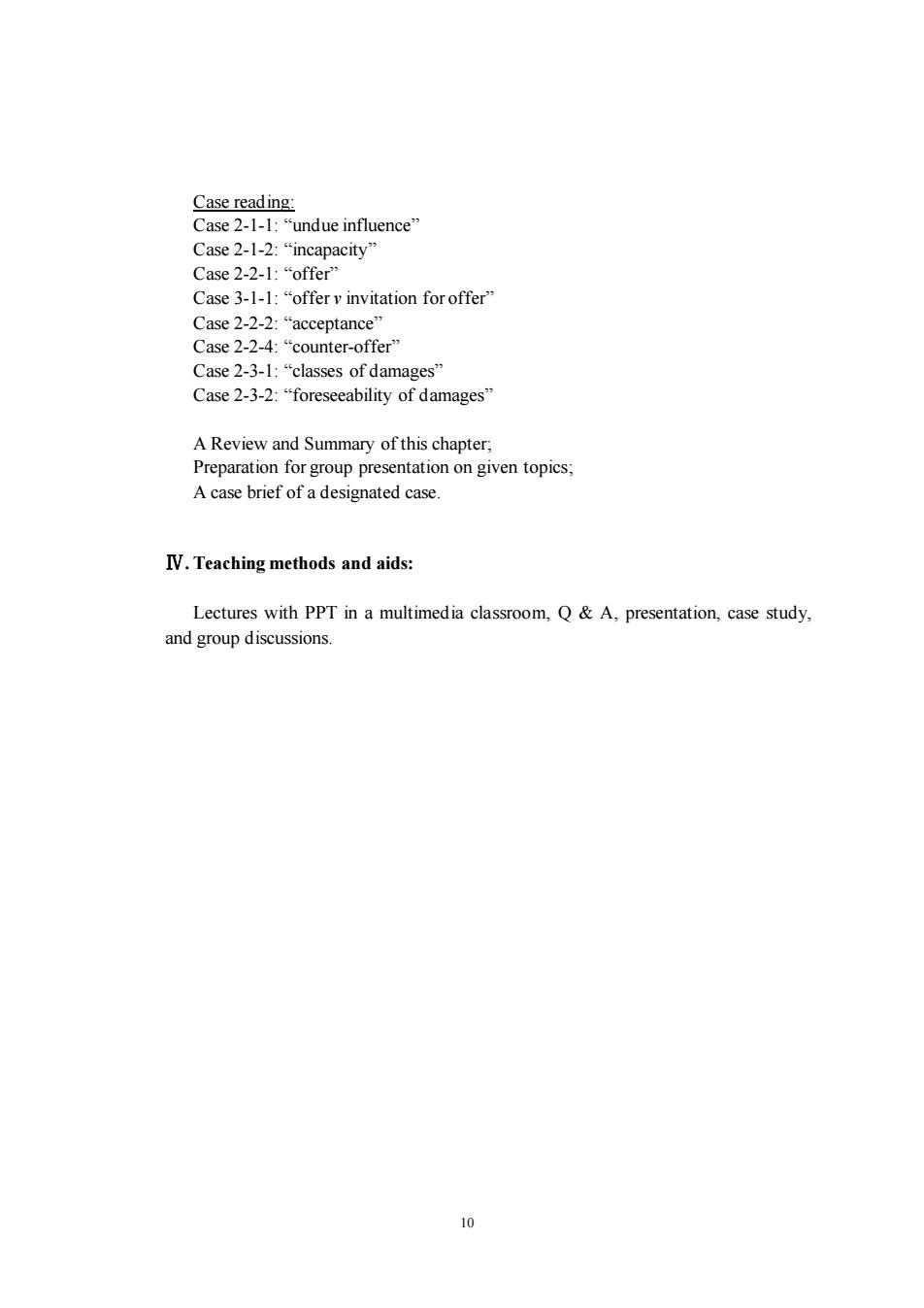
Case reading Case 2-1-1:"undue influence" Case2-1-2: Case2-2-1 pacity offe Case 3-1-1:"offer v invitation for offer" Case 2-2-2:"acceptance" Case 2-2-4:"counter-offer" Case 2-3-1:"classes of dama Case2-3-2: foreseeability of damages' A Review and Summary of this chapter; Preparation for group presentation on given topics. A case brief of a d signated case IV.Teaching methods and aids: Lectures with PPT in a multimedia classroom,Q&A,presentation,case study. and group discussions 10
10 Case reading: Case 2-1-1: “undue influence” Case 2-1-2: “incapacity” Case 2-2-1: “offer” Case 3-1-1: “offer v invitation for offer” Case 2-2-2: “acceptance” Case 2-2-4: “counter-offer” Case 2-3-1: “classes of damages” Case 2-3-2: “foreseeability of damages” A Review and Summary of this chapter; Preparation for group presentation on given topics; A case brief of a designated case. Ⅳ. Teaching methods and aids: Lectures with PPT in a multimedia classroom, Q & A, presentation, case study, and group discussions